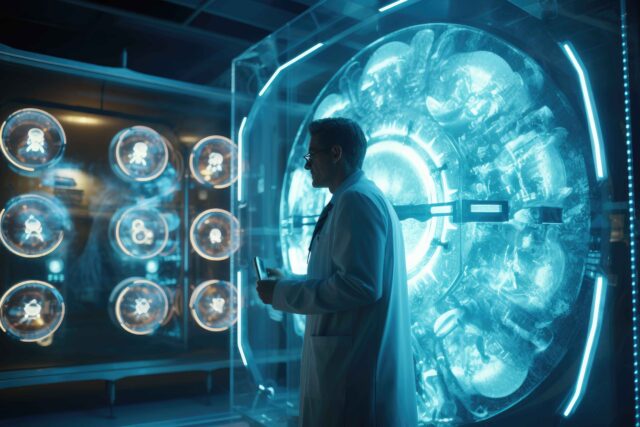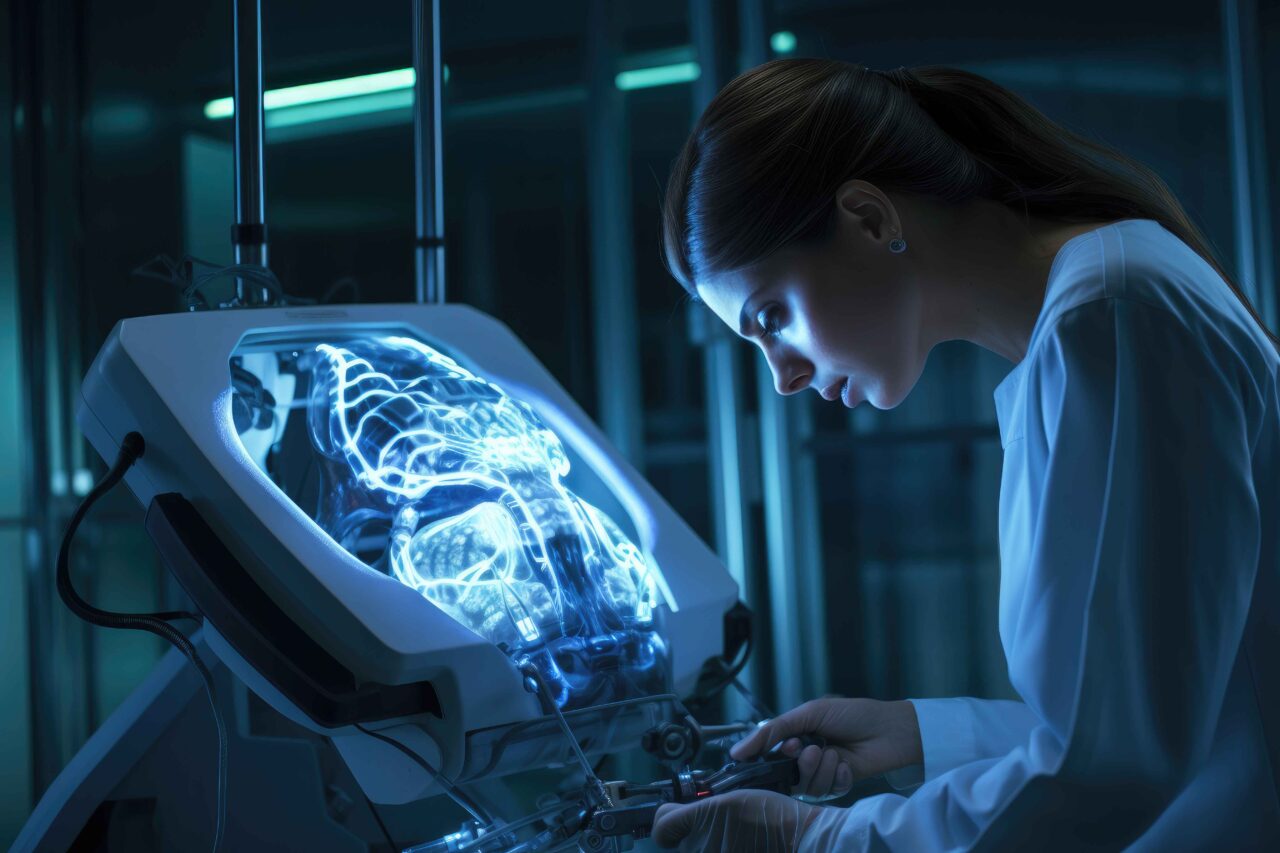Medical imaging, like X-rays, CT scans, and MRIs, has always been central to diagnosing illnesses. Recently, artificial intelligence (or AI) has begun partnering with doctors in reading those scans. In this post, I want to explain, in plain English, what this “AI-powered image-reading” actually means, why it matters, and how making healthcare better and easier for everyone to understand.

What is “AI Diagnostic Imaging”?
Let’s start with the basics. When you get a medical scan, say, of your chest or knee, a radiologist (a specialist doctor) looks at it and checks for anything unusual, like a broken bone or a tumour. AI diagnostic imaging refers to using computer programs, trained to recognize patterns, to help spot or highlight things that might be hard to see with just the human eye. Think of AI as an extra set of eyes that’s been trained well.
Over the last few years, these AI tools have learned to notice things like small fractures, early-stage tumours, or signs of stroke, sometimes even faster than a human can. And they do it consistently, 24/7, without getting tired.
Why Are We Hearing About It So Much?
Three big reasons:
- It’s faster. In busy hospitals, especially in emergencies, speed matters. AI can flag urgent findings almost instantly, helping doctors act faster.
- It’s reliable. These tools are trained on thousands-or even millions-of images. That means AI can recognize subtle patterns that even an expert might miss occasionally.
- It’s getting approved. Regulators in places like the U.S. and Europe are starting to authorize these tools for real-world clinical use. That means hospitals are actually using them, not just researching them anymore.
Put simply: when a tool is fast, accurate, and regulated, hospitals take notice.
What Does This Look Like In The Real World?
Let me walk you through some everyday examples:
- Mammograms and cancer screening
AI can flag tiny suspicious areas on breast scans. That gives doctors a clearer picture of what to follow up on, without replacing the doctor. - Chest X-rays
For things like pneumonia or lung nodules, AI can highlight areas of concern so radiologists can double-check. It’s like having a helpful post-it note on the image. - Stroke scans
In stroke cases, every second counts. AI can instantly check brain scans for signs of bleeding or blockages, speeding up treatment decisions. - Bone injuries
AI tools can pick out fractures in wrists, ankles, or spines, especially when the break is tough to see or the radiologist is looking at many images in one day.
In all these cases, AI helps doctors spot what matters fast, without taking over.
How Does It All Work?
Here’s a human-friendly breakdown:
- Gather lots of images – X-rays, MRIs, CTs-these get labelled (e.g., “has fracture” or “no tumour”) by experts.
- Train the AI – A computer model studies the labelled images, learning to spot patterns.
- Test it on new scans – Before hospitals use it, the AI is tried out on fresh scans to check accuracy.
- Integrate into workflow – Finally, it’s connected to hospital systems so AI can flag things, and doctors confirm or override the findings.
That last step-workflow integration-is key. The best AI tool is only useful if it fits smoothly into how doctors already work.
Benefits We’re Already Seeing
- Shorter wait times – Especially in large hospitals, scans can sit unreviewed for hours. AI can flag urgent cases right away.
- Fewer missed findings – Nobody’s perfect. Computers don’t get bored or daydream, so they can notice things that slip past a tired human eye.
- Better quality control – AI can check that scans are labelled correctly and meet the needed standards, saving time for everyone.
- More reach – In small or remote clinics, AI tools provide support even where specialist doctors aren’t available.
But It’s Not Magic-There Are Limits
It’s important to understand what AI cannot do:
- It’s not a doctor. AI provides suggestions, but every result still needs a human to interpret it in context, like the patient’s symptoms, history, and other test results.
- Bias can sneak in. If an AI tool is trained mostly on scans from one demographic group, it might not work as well for others. That’s why researchers aim for tools tested on diverse populations.
- It makes mistakes, too. False alarms happen. That’s why the doctor’s judgment remains essential.
- Regulatory reviews take time. Hospitals and governments must make sure AI tools are safe, reliable, and respect patient privacy. That process is ongoing.
What’s Coming Next?
There’s exciting progress ahead:
- Better explanations – Future tools will provide clear ‘reasoning’ hints along with their picks, like highlighting exactly why a spot looks suspicious.
- Real-time help in surgery. Imagine a surgeon getting an AI overlay during an operation, showing them precisely where blood vessels or tumours are.
- Integrated diagnostics. AI could connect images, genetics, blood tests, and patient history to give a fuller picture, helping doctors tailor treatment.
- Global access. Low-cost AI tools mean clinics in remote regions get expert-level imaging support no matter where they are.
What Does It Mean For You, The Patient?
- Faster answers. If your scan shows something concerning, AI can help your doctor spot it sooner, with less waiting, more getting treated.
- Reduced anxiety. If images sit untouched for hours or days, that’s stressful. AI helps cut that delay.
- More personalized care. Spotting subtle warning signs can lead to earlier monitoring or treatment and better outcomes.
- Fairer treatment. In places with few specialists, AI can help give patients care closer to what they’d get in big cities.
A Day In The Life With AI Support
Let’s picture a typical day at a hospital:
- A patient comes in with chest pain. A CT scan suggests a possible blood clot in the lung.
- The scan is done, and within seconds, the AI flags the scan for “suspected pulmonary embolism.”
- The radiologist reviews and confirms. Because it was flagged right away, treatment starts fast.
- Meanwhile, other scans-like X-rays from outpatient visits-are quietly checked by AI for fractures or nodules. Radiologists review those findings during regular shifts, focusing on real human exceptions.
The result? Faster emergency care, fewer errors, and less manual scanning through stacks of images.
Summary
AI diagnostic imaging isn’t sci-fi, it’s already here. It works quietly in hospitals, pointing radiologists toward what matters so they can focus on making sense of it. And it does so in a way that helps doctors work better, not that it replaces them.
For patients, that means quicker scans, clearer results, and more confident care. For doctors, it means less repetitive work, fewer missed details, and more time for thoughtful decision-making.
AI and radiologists-a smart team for better health.


